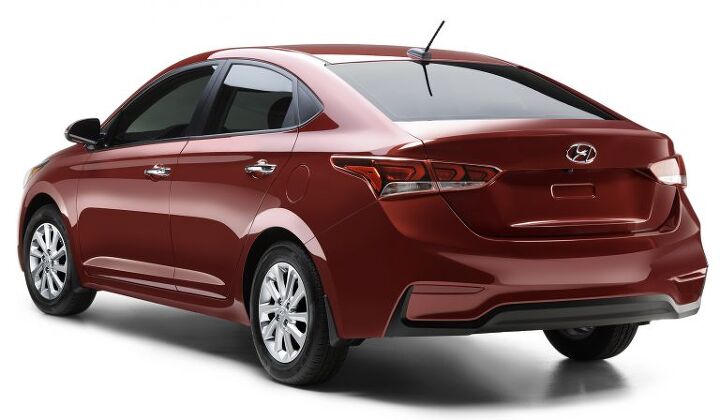2018 Hyundai Accent - Familiar Lines on a Not-so-subcompact Subcompact

Does it look familiar?
If you haven’t seen a new product from Hyundai in the past year and a half, your answer is probably a half-hearted “maybe.” However, the 2018 Hyundai Accent borrows enough design cues from the larger Elantra that the answer should be a solid “Oh, definitely.”
Introduced today at the Canadian International Auto Show in Toronto, the fifth-generation Accent promises more of the things that matter: interior room, length, width, acceleration and fuel economy.
It also breaks from the past in another way. Due to its growth spurt, the Accent — once among the most diminutive cars on the road — can now be classified as a compact.
So, how much did the Accent grow? Inside, volume is up by 1.27 cubic feet in sedan form, and 1.34 cubes in five-door hatchback guise. Cargo volume in the hatch increases by just over half a cubic foot. Not a huge increase, but vehicles have a way of nudging the size ceiling to compete in their respective segments. Many exist just inside the boundaries of their size class.
Outside, the Accent adopts the long bodyside lines of the Elantra, boosting the vehicle’s impression of length. The wide corporate grille has a similar effect, bringing a newfound sense of “serious car” width to the entry-level model. It’s not all in your mind, however. Overall length of the sedan is up six-tenths of an inch, while the hatch now stretches an extra 2.8 inches.
Both bodystyles see four-tenths of an inch added to the wheelbase and an extra 1.1 inches of width. Roof height has stayed put, thought ground clearance has shrunk by four-tenths of an inch.
Hyundai Canada claims the Accent’s newly stiffened body boasts 13 percent more high-strength steel than before, translating into a 32-percent increase in torsional rigidity. That helps eliminate noise/vibration/harshness issues and improve ride quality. The automaker has also installed new rear shocks and a motor-driven power steering system for improved handling.
Inside, the industry-wide trend of packing more content and premium cues into compact and subcompact vehicles continues. More soft-touch surfaces, a standard backup camera and upgraded touchscreen display — which maxes out at 7 inches — joins firmness-adjustable seats for comfortable long-range cruising. A proximity key and push-button start is offered on higher-end trims, as is automatic emergency braking.
Crash protection is also expected to top the previous generation, thanks to reinforcements added to defeat the small overlap crash test.
For 2018, Hyundai engineers fine-tuned the direct-injection 1.6-liter four-cylinder engine for economy and passing performance. Power output drops, from 137 horsepower and 123 lb-ft of torque in 2017 models to 132 hp and 119 lb-ft in next-generation guise. While this would seem to make the new Accent pokier, it isn’t the case.
The automaker claims available torque at 1,500 rpm has increased 4.6 percent, which aids in launches, while acceleration times have been shortened by two-tenths of a second between 25 and 50 miles per hour, and by 1.3 seconds between 50 and 75 miles per hour. Hyundai is aiming at driveability with these improvements. Fuel economy should increase by 7 percent, Hyundai claims.
The same six-speed manual found in the current generation can also be found in the 2018 Accent, though the six-speed automatic has been reworked to shed weight. Automatic models also gain a Sport mode button to wring extra performance from the engine.
While subcompacts aren’t as hot as, say, anything with available all-wheel drive, Hyundai needs to stay competitive in a segment where the Accent currently ranks Number 2. The Accent finished behind the Versa in sales last year, but it did see its sales rise 30 percent to 79,766 units, occupying 17 percent of a segment that slid 3 percent in 2016.
The 2018 Hyundai Accent sedan arrives on dealer lots in the fourth quarter of 2017, with the five-door variant appearing on Canadian lots in early 2018. Sorry, America, only sedans for you.
[Images: Hyundai Auto Canada]

More by Steph Willems
Latest Car Reviews
Read moreLatest Product Reviews
Read moreRecent Comments
- Tassos You can answer your own question for yourself, Tim, if you ask instead"Have Japanese (or Korean) Automakers Eaten Everyone's Lunch"?I am sure you can answer it without my help.
- Tassos WHile this IS a legitimate used car, unlike the vast majority of Tim's obsolete 30 and 40 year old pieces of junk, the price is ABSOLUTELY RIDICULOUS. It is not even a Hellcat. WHat are you paying for? The low miles? I wish it had DOUBLE the miles, which would guarantee it was regularly driven AND well maintained these 10 years, and they were easy highway miles, not damaging stop-go city miles!!!
- Tassos Silly and RIdiculous.The REAL Tassos.
- Lostboy If you can stay home when it's bad out in winter, then maybe your 3 season tire WILL be an "ALL-SEASON" tire as your just not going to get winters and make do? I guess tire rotations and alignments just because a whole lot more important!
- Mike My wife has a ‘20 Mazda3 w/the Premium Package; before that she had a ‘15 Mazda3 i GT; before THAT she had an ‘06 Mazda Tribute S V6, ie: Ford Escape with a Mazda-tuned suspension. (I’ve also had two Miata NAs, a ‘94 & a ‘97M, but that’s another story.) We’ve gotten excellent service out of them all. Her 2020, like the others before it, is our road trip car - gets 38mpg highway, it’s been from NC to Florida, Texas, Newfoundland, & many places in between. Comfortable, sporty, well-appointed, spacious, & reliable. Sure, we’d look at a Mazda hybrid, but not anytime soon.😎



































Comments
Join the conversation
The same old sausage in differing lengths is now running strong at Hyundai. So predictable.
Why buy this new over a far better engineered 1-2 YO used car?